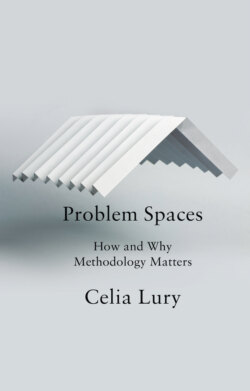Читать книгу Problem Spaces - Celia Lury - Страница 16
Approach 2: Simon
ОглавлениеLike Dewey, Herbert Simon is of the view that a problem is not given but must be created. In doing so, he introduces the concept of problem space:
Every problem-solving effort must begin with creating a representation for the problem – a problem space in which the search for the solution can take place. (1996: 108)
He argues that, as a purposeful representation, a designed problem space is a methodological artifact that is always ‘in imminent danger of dissolving and vanishing’ (1996: 131). It is sustained, however, by the boundary or artificial sciences. This is the term he uses to describe the set of methodological practices by which design2 can be refined to be beneficial to society. A key element of design for Simon is the partitioning of a complex problem into sub-problems through boundary-making. Through boundary-making, Simon says, problem-solving can often be accomplished through the use of relatively simple recursive operations such as those performed by bundles of algorithms. He uses the analogy of a pair of scissors to describe boundary-making or partitioning: he writes: ‘Human rational behavior … is shaped by a scissors whose blades are the structure of task environments and the computational capabilities of the actor’ (1990: 7).
Simon’s ideas lend themselves to be taken up in an instrumental – means–ends – fashion. His advocacy of the method of optimization, for example, is often interpreted as involving the recursive use of three classes of processes: search rules, stopping rules and decision rules, in relation to predetermined goals. However, while Simon’s proposals were intended to have clear practical implications (like Dewey, Simon was concerned with the transformation of situations), he explicitly argues against the use of pre-determined goals in problem-solving. Indeed, not only does he stress the multiplicity and variety of satisfactory rather than optimum solutions (satisficing), he also emphasizes the contingency of the process of reaching a solution and describes negotiating the process of reaching a variety of solutions in terms of style.
Variety, within the limits of satisfactory constraints, may be a desirable end in itself among other reasons because it permits us to attach value to the search as well as its outcome – to regard the design process as itself a valued activity for those who participate in it. (1996: 130)
He argues that problem-solving systems should not merely assemble solutions but must rather ‘search for appropriate assemblies’ (1996: 124).
Simon further argues for the importance of discovering new representations of problems, rather than merely deploying existing framings of a problem, even while acknowledging that the process of discovery is poorly understood. In describing this process, the terms ‘situation’ and ‘relevance’ (both of great importance to Dewey) creep in:
Focus of attention is the key to success – focusing on the particular features of the situation that are relevant to the problem, then building a problem space containing these features but omitting the irrelevant ones. This single idea falls far short of a theory of representation change but takes a first step toward building such a theory. (1996: 109)
He argues that it is only the practice of search guided by ‘the most general heuristics of ‘interestingness’ or novelty [that] is a fully realizable activity’ (1996: 162), and says, ‘A paradoxical, but perhaps realistic, view of design goals is that their function is to motivate activity which in turn will generate new goals’ (1996: 162). Indeed, he proposes that ‘One can envisage a future … in which our main interest in both science and design will lie in what they teach us about the world and not in what they allow us to do to the world’ (1996: 164). He provides here a way of thinking about how methodology might direct the continuity-in-transformation of problems to realize epistemological values.
